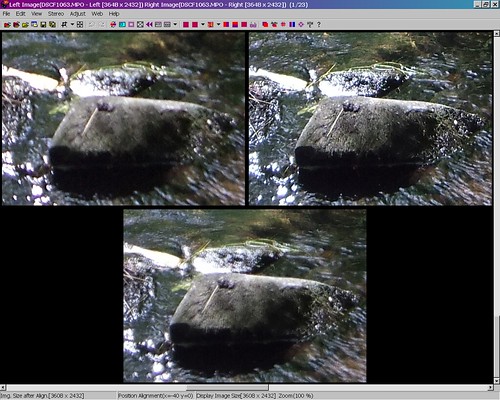
This is the left image of the pair. I remember vividly focusing on the large stone in the center of the foreground (confirmed when looking at the parallax in the foreground picture below). Not the greatest focusing point but the camera didn't complain when taking the picture so I can only assume it was good enough.

This is a close-up of the foreground in StereoPhoto Maker (I am using the stereo adjustment view at normal size). You can clearly see that the right picture is focused (expected, because that's where I actually focused the shot) while the left picture is blurry (not good).

This is a close-up of the background. Now, the right picture is blurry (expected) while the left picture is more in focus.
I've chosen this picture because there's quite a bit of distance between the foreground and background and it really shows where the left lens is focusing (it's focusing on something much farther than the right lens). With other pictures, when there's not much distance in the shot between foreground and background, it kinda seems that the left lens is blurry all over (probably because it's focused on a point who knows where).
This seems kinda strange that the two lenses are not focusing on the same point but, for the sake of discussion, let's assume that the two lenses do indeed focus independently. Then, this whole thing could very well be an auto-focus problem when the object that's focused on is not super well defined against the background, especially in low light condition just like in the picture above (I've seen the same thing happen in bright light though). I have no problem with the auto-focus not being able to lock but then, why does the camera say it can focus (focus light is green and camera beeps) and, more importantly, why is the difference in focus distances between the two lenses so large? And this leads to another question: If the two lenses focus on possibly two different things, how can the camera's software figure out the parallax in auto mode? The problem is that you have no idea you're out of focus until you go into StereoPhoto Maker and check the parallax at normal size. If the camera can't focus, no problem, just let me know about it and I can take the appropriate action (hopefully).
This is the wiggle (Piku-Piku) version from Start 3D (kinda like what StereoTracer from triaxes.com does). Obviously, if you only intend to show wiggles from your Fuji W3 mpo files, then being slightly out of focus on one lens may be the least of your worries.
Well, since then, I have taken a few more pictures in better light conditions and using better focus points, and it seems that the auto-focus behaves better. The two images are usually equally blurry under 100% magnification. Conclusion: the lenses on the Fuji w3 are not very good, to put it nicely.

I created an extended review of 4 camera samples of this Fujifilm FinePix Real 3D. If you are interested you can find it at the link below. There are no ads and nothing to buy. So I do not want to lure you there because of clicks.
ReplyDeletehttp://review-fujifilmfinepixreal3d.weebly.com
Assuming the left and right images you're showing on your website are at 100% magnification, the behavior of the your w3 in terms of focusing is pretty common. Not much you can do about it. I don't think sending it to fuji will solve anything.
ReplyDeleteNo - most samples are not magnified at all. They look at this small size already that bad.
ReplyDeleteAh ok, it's definitely not normal then.
ReplyDeleteI've just discovered the same issue with my Finepix W3, which I've had for about three weeks. I did a quick Google and found your post.
ReplyDeleteLike you, I'm seeing the left image being a little out of focus compared to the right. It seems more noticeable when things are further away, and in my case it seems to be more noticeable on the right-hand side of the left image than the left-hand side of it.
None of it is a massive dealbreaker for me, but having noticed it I now won't be able to un-notice it.
Haha, sorry about that. you can't expect too much from a relatively cheap twin-ccd camera. i don't think it's a super big deal. try to make sure you're focusing on objects that well defined against the background. also, the grain will be less noticeable when the ISO is at 100 (rather than 400 or 800, which the camera switches to under low light).
ReplyDeleteI have known about this issue almost since the introduction of the W3. That is why I never wanted to purchase one. But recently, I was offered one "mint in the box" at a good price, so went for it after several other owners told me that their W3 lenses focused properly...
ReplyDeleteWell, wouldn't you know it, my camera has the left lens focus problem as well. So I decided to go and take a look at some official Fuji samples and - sure enough - the problem shows up even in the official samples.
This is really a design flaw and Fuji should have been required to correct it.
It seems to me that Fuji have copied the Wray DepthMaster system and have deliberately made the two lenses focus at different distances. This is a good idea as it gives you a greater depth of field which is something usually desirable in stereo photography. Read about the Wray Stereo Graphic if you want to know more. I have one of these. When viewed in stereo your eyes will give preference to the sharpest image so using the DepthMaster system then both close up objects will be in good focus (from the right lens) and distant objects will be in focus (from the left lens). I think it is supposed to work like that so don't worry about it.
ReplyDeleteHere is a pictorial explanation of the Graflex (not Wray) DepthMaster system. I am sure that Fuji have copied this idea (I think it is covered by a Graflex patent but then I doubt the company still exists). This was intended for a fixed focus stereo camera. You will see that the right lens focuses on near objects and up to 30 ft while the left lens focuses from 15ft to infinity.
ReplyDeletehttp://www.flickr.com/photos/nesster/3933992372/sizes/o/in/photostream/
thanks for the info!
DeleteMe again (Graflex Depthmaster guy). I got this camera. It is utterly superb compared to the Stereo Realist and Wray Stereo Graphic film cameras that I have tried to get decent results out of in the past. Please don't judge this camera against normal 2D cameras for image quality because it is not meant for that purpose. You would be doing it a great disservice. As for 10 Mpixels then I laughed when I saw it. They only do that because nobody would buy it if it were a 1 Mpixel sensor. But I would because that is all the lenses are capable of resolving and it would give me three extra stops and a bit more before the sensor noise kicked in. 3D photography is totally different to normal photography. What you are aiming for is plenty of variety of depth in your scene going from near to far with the far background broken up by nearer features so the background does not look like wallpaper like the background scene in a stage play. You are creating a 3D visual delight and you have to compose and get the content of your shots just right. It is a totally different photographic art form. And don't worry about the focal distances of each lens not matching because it works better if they do not. As for the image resolution then do yourself a favour by setting it to Small Fine for still shots because that is more than the lenses are capable of in any case. For video then use highest resolution and get yourself a 32GB San Disk SDHC to give yourself enough capacity (not higher GB as it won't accept it). Considering the years of disappointment and frustration with 35mm film stereo cameras I think I just arrived in heaven. :-)
ReplyDeleteThis camera is no longer sold on the UK market. but is still available direct from Japan. It is no surprise - there are more things wrong with it than right with it - the focus difference being just one. The human interface was devised by something that was half paying attention when humans were covered in exobiology class. The image quality in low light is laughable and bettered by most smart phones. The video quality matches that of a previous generation of phone. What is frustrating that it falls between too stools - it is (was) neither cheap enough to be regarded as expendable nor expensive enough to be developed right (with lots of alpha and beta testing). Sad thing is that short of custom rigs for DSLRs or CSCs it is still the best stereo camera on the market.
ReplyDelete